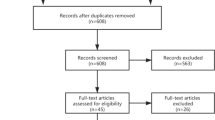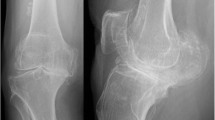Abstract
Introduction
When highly conforming polyethylene inlays were introduced into total knee arthroplasty (TKA), they were characterized as adding anteroposterior stability to the reconstructed knee. The aim of this study was to examine the patellofemoral pressure with the designs of a highly conforming and a posterior stabilized inlay. The patellofemoral pressure depends among other factors on the anteroposterior stability of the knee joint.
Materials and methods
Eight fresh frozen human knee specimens underwent testing in a kinematic device. Knee motion was driven by a hydraulic cylinder at an extension moment of 31 Nm. The patellofemoral contact pressure was measured using a pressure sensitive film (Tekscan®, Inc., Boston, USA). First, this was assessed after implantation of a cruciate retaining (CR) TKA with a highly conforming polyethylene insert before and after resection of the posterior cruciate ligament. After that, the same measurements were performed with a similar posterior stabilized prosthesis.
Results
Patellofemoral contact pressures in the CR prosthesis using the highly conforming inlay were not significantly different before and after resection of the posterior cruciate ligament. However, after implantation of a posterior stabilized prosthesis peak pressure was significantly lower [Mean: 6.12, (SD 2.37) MPa] in comparison to the highly conforming type [7.12, (SD 2.53) MPa, P < 0.01] at a preserved posterior cruciate ligament. Further to that, the mean contact pressure turned out to be lower with the posterior stabilized design (P < 0.006).
Conclusion
The results of this study suggest that a posterior stabilized prosthesis design reduces the patellofemoral peak and mean pressure in comparison with a high conforming design. The better reproducible femoral rollback with a posterior stabilized model at a tibial ventral shift could serve as a possible explanation.





Similar content being viewed by others
References
Laskin RS, Maruyama Y, Villaneuva M, Bourne R (2000) Deep-dish congruent tibial component use in total knee arthroplasty: a randomized prospective study. Clin Orthop Relat Res 380:36–44
Sharkey PF, Hozack WJ, Rothman RH, Shastri S, Jacoby SM (2002) Insall Award paper. Why are total knee arthroplasties failing today? Clin Orthop Relat Res 404:7–13
Hsieh HH, Walker PS (1976) Stabilizing mechanisms of the loaded and unloaded knee joint. J Bone Joint Surg Am 58(1):87–93
Scott RD, Thornhill TS (1994) Posterior cruciate supplementing total knee replacement using conforming inserts and cruciate recession. Effect on range of motion and radiolucent lines. Clin Orthop Relat Res 309:146–149
Stukenborg-Colsman C, Ostermeier S, Hurschler C, Wirth CJ (2002) Tibiofemoral contact stress after total knee arthroplasty: comparison of fixed and mobile-bearing inlay designs. Acta Orthop Scand 73(6):638–646
Stukenborg-Colsman C, Ostermeier S, Wenger KH, Wirth CJ (2002) Relative motion of a mobile bearing inlay after total knee arthroplasty–dynamic in vitro study. Clin Biomech (Bristol, Avon) 17(1):49–55
Matsuda S, Ishinishi T, White SE, Whiteside LA (1997) Patellofemoral joint after total knee arthroplasty. Effect on contact area and contact stress. J Arthroplasty 12(7):790–797
Bohnsack M, Klages P, Hurschler C, Halcour A, Wilharm A, Ostermeier S, Ruhmann O, Wirth CJ (2006) Influence of an infrapatellar fat pad edema on patellofemoral biomechanics and knee kinematics: a possible relation to the anterior knee pain syndrome. Arch Orthop Trauma Surg 13
Huberti HH, Hayes WC, Stone JL, Shybut GT (1984) Force ratios in the quadriceps tendon and ligamentum patellae. J Orthop Res 2(1):49–54
Kaufer H (1971) Mechanical function of the patella. J Bone Joint Surg Am 53(8):1551–1560
Ostermeier S, Hurschler C, Stukenborg-Colsman C (2004) Quadriceps function after TKA—an in vitro study in a knee kinematic simulator. Clin Biomech (Bristol, Avon) 19(3):270–276
Ostermeier S, Hurschler C, Windhagen H, Stukenborg-Colsman C (2006) In vitro investigation of the influence of tibial slope on quadriceps extension force after total knee arthroplasty. Knee Surg Sports Traumatol Arthrosc 14(10):934–939
Rand JA (1994) The patellofemoral joint in total knee arthroplasty. J Bone Joint Surg Am 76(4):612–620
Lynch AF, Rorabeck CH, Bourne RB (1987) Extensor mechanism complications following total knee arthroplasty. J Arthroplasty 2(2):135–140
Boyd AD Jr, Ewald FC, Thomas WH, Poss R, Sledge CB (1993) Long-term complications after total knee arthroplasty with or without resurfacing of the patella. J Bone Joint Surg Am 75(5):674–681
Stukenborg-Colsman C, Ostermeier S, Burmester O, Wirth CJ (2003) Dynamic in vitro measurement of retropatellar pressure after knee arthroplasty. Orthopade 32(4):319–322
Fuchs S, Skwara A, Tibesku CO, Rosenbaum D (2005) Retropatellar contact characteristics before and after total knee arthroplasty. Knee 12(1):9–12
Wendt PP, Johnson RP (1985) A study of quadriceps excursion, torque, and the effect of patellectomy on cadaver knees. J Bone Joint Surg Am 67(5):726–732
Insall JN, Lachiewicz PF, Burstein AH (1982) The posterior stabilized condylar prosthesis: a modification of the total condylar design. Two to four-year clinical experience. J Bone Joint Surg Am 64(9):1317–1323
Author information
Authors and Affiliations
Corresponding author
Rights and permissions
About this article
Cite this article
Heyse, T.J., Becher, C., Kron, N. et al. Patellofemoral pressure after TKA in vitro: highly conforming vs. posterior stabilized inlays. Arch Orthop Trauma Surg 130, 191–196 (2010). https://doi.org/10.1007/s00402-009-0920-y
Received:
Published:
Issue Date:
DOI: https://doi.org/10.1007/s00402-009-0920-y




